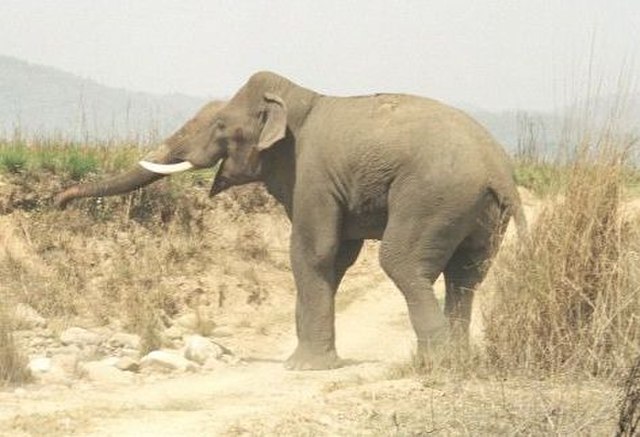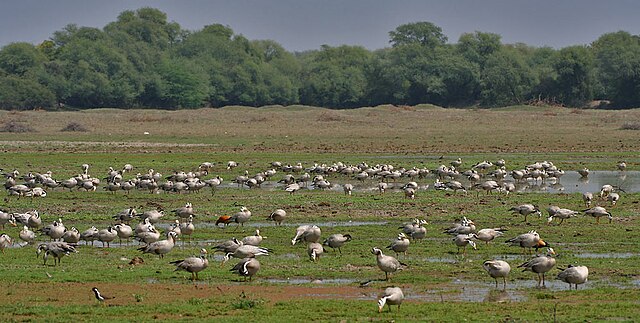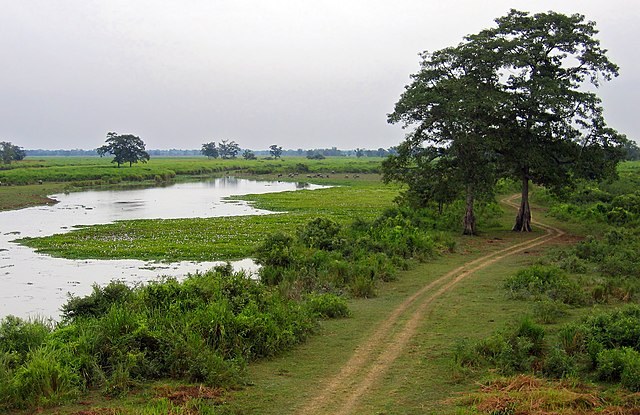Park Narodowy Keoladeo (केवलादेव राष्ट्रीय उद्यान)
Park Narodowy Keoladeo – park narodowy w Indiach, we wschodniej części Radżastanu, w okolicach miasta Bharatpur, założony w celu ochrony ptactwa. Na terenie Parku (2873 ha) zamieszkuje na stałe lub przebywa w czasie migracji łącznie ponad 370 gatunków ptaków.
Jest to około jedna czwarta wszystkich gatunków ptaków zamieszkujących subkontynent indyjski. Kępy drzew akacjowych są dobrym miejscem na gniazdo, np. dla dławigadów indyjskich. Ponadto na terenach podmokłych Parku Keoladeo występuje żuraw indyjski (Grus antigone), marabut indyjski (Leptoptilos dubius), kleszczak azjatycki (Anastomus oscitans), wężówka indyjska (Anhinga melanogaster), czapla siodłata (Ardeola grayii) i długoszpon chiński (Hydrophasianus chirurgus) oraz warzęchy, ibisy, pelikany, kormorany i różne ptaki szponiaste, w tym co najmniej 9 gatunków orłów.
Innymi zwierzętami zamieszkującymi teren parku są: kot trzcinowy, taraj, łaskun muzang, szakal, hienowate, nietoperze z rodzaju Pteropus, jeżozwierze, antylopa nilgau indyjski, sambar indyjski, mangustowate. Z gadów występują tu agamy z rodzaju Calotes, waran bengalski, niektóre węże z rodziny połozowatych, w języku angielskim określane Rat snakes, niemrawiec indyjski, kobry, żmijowate i zaskroniec indyjski (Xenochrophis piscator). Odnotowano około 35 gatunków motyli, a także 50 gatunków ryb, w tym brzeszczotka azjatyckiego, ryby z rodzaju Cirrhinus (rodzina: karpiowate) i ryby z rodzaju Ompok.Tereny parku, położone w depresji pomiędzy rzekami Gambhir i Banganga, pierwotnie były obszarami zalewowymi, zatapianymi w czasie pory deszczowej. W XVIII wieku, za sprawą władcy Bharatpuru, maharadży Surai Mala w celu utworzenia rezerwuaru wody dla celów rolniczych, tereny te zostały na stałe zatopione. W latach 1850–1899 system tam i kanałów został rozbudowany, w wyniku czego znacznie zwiększyła się pojemność rezerwuaru. Podmokłe tereny stały się ulubionym miejscem postoju ptaków wędrownych. Począwszy od połowy XIX wieku władcy Bharatpuru zaczęli traktować obszar jako tereny łowieckie. Ochrona ptaków na terenie dzisiejszego parku została zainicjowana w 1902 roku przez późniejszego wicekróla Indii, George'a Curzona. W 1956 roku teren został oficjalnie uznany za rezerwat ptaków, a w 1965 zakazane zostały polowania na terenie Parku. W 1981 Keoladeo został uznany za park narodowy, a w 1985 roku został wpisany na listę światowego dziedzictwa UNESCO.
Links
Images Gallery
Comments
-
The animal and Bird Paradise. No need for a guide. Even the rickshaw wallahs are trained alike. Cycles don't work good so don't use cycles and go up in any one open view tower and see through binoculars. You will see many animals and birds... There are many birds and some animals. A very good National Park.... Must visit...
3 weeks ago -
Best place to visit for wildlife lovers and it is situated in bharatpur and it is on the national highway and this place is very beautiful, there are mostly herbivores animals and the birds are also very beautiful sometime in winters you can find migrating birds also. They have a guest house also inside the park and sometime they provide safari ride also.
3 weeks ago -
It was a treat to be able to visit here and see an amazing range of birds, most relatively close to the main walkways. Or, better still, take a rickshaw ride. We stayed quite close to the park entrance, at The Birders Inn - highly recommended - and actually took the rickshaw from there and return. We got to the park just before sunrise - a great time to start - and spent about 4 hours on the whole experience. But be warned, food, drink and other conveniences are scarce, so go prepared. Cost of entry is quite cheap. Well worth a visit if in the area or travelling from Jaipur to Agra.
8 months ago -
-
Commonly known as Bharatpur Bird Sanctuary, Keoladeo National Park is home to a variety of hundreds of species of birds. The landscape is beautiful. It is spread over an area of 29 sq km, out of which 10 sq km comprises of fresh shallow lakes & water marshes. Since the track you can follow is several kilometres, they offer bicycle or tricycle (rickshaw) rentals to help cover it. The whole place can take 4-5 hours easily to cover it, so I recommend do not waste your time in the beginning area of the park. The main attraction begins after the first check-point, so it's best to move directly to it. We went there mid November and did find a lot of migratory birds there.
9 months ago -
Keoladeo National Park or Better known as Bird Sanctuary is the most famous tourist attraction in Bharatpur, Rajasthan. It is a World Heritage Site (1 out of 40 in India) Best season: Peak Winters (Dec-Jan) Best way to Explore: Either rent a Bicycle or take a Rickshaw. For Bird 🦅 sighting, you need to have patience. Better to start early morning. (6AM) There use to be a small canteen at the end of the park for quick bites/snacks. ⚠️ Don’t through any kind of litter in the park.
2 weeks ago -
A beautiful birding place. You sight some nice species and if you are new into bird photography, this is the right place to be.
5 months ago -
Visited Keoladeo National Park as a part of our Golden Triangle Tour of India. We rode in a three seater golf cart for our tour, with a guide and driver. You could also walk or take a three-wheeled bike tour. Our guide was very knowledgeable and helped us identify birds and animals we were lucky enough to see on this tour. The property was a private hunting preserve at one time. Saw the following birds: Juvenile purple huron, Black billed ibis, Sarus crane with red head, like our sandhill crane, Spotted billed duck, White spoonbills, Stilt with black beak and legs, Painted stork, Bar headed goose from Mongolia, Anhinga, Fruit bat or flying fox, Green parakeet, Lesser spotted eagle and a Red myna bird.
a year ago




















































































